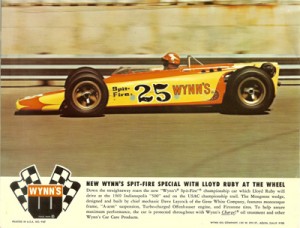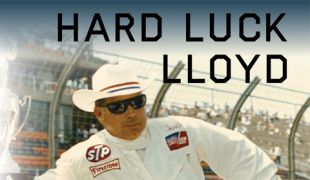Excerpt from Hard Luck Lloyd: The one that got away
IndyCar, IndyCar commentary — By More Front Wing Staff on December 9, 2013 1:06 pm The following is our third and final excerpt from Hard Luck Lloyd: The Complete Story of Slow-Talking, Fast-Driving Texan Lloyd Ruby. The book was written by More Front Wing contributor John Lingle and features more than 280 color and black and white photographs interspersed with interviews from racing greats like Mario Andretti, Al and Bobby Unser, Johnny Rutherford, Parnelli Jones, and Dan Gurney. Hard Luck Lloyd is available for order now from Racemaker Press and Coastal181.com.
The following is our third and final excerpt from Hard Luck Lloyd: The Complete Story of Slow-Talking, Fast-Driving Texan Lloyd Ruby. The book was written by More Front Wing contributor John Lingle and features more than 280 color and black and white photographs interspersed with interviews from racing greats like Mario Andretti, Al and Bobby Unser, Johnny Rutherford, Parnelli Jones, and Dan Gurney. Hard Luck Lloyd is available for order now from Racemaker Press and Coastal181.com.
John is currently running a contest to give away a copy of the book, which ends tomorrow! Simply follow him on Twitter @jdlingle and retweet his contest tweet for your chance to win. The draw takes place tomorrow, December 10th.
—
‘THE ONE THAT GOT AWAY’
Ruby entered 1969 as a front-runner for Indy in many people’s minds. His work with Gene White Racing, Dave Laycock, and Firestone had set him up financially and shown racing fans what the slow-talking Texan could do in good equipment. Wynn’s had come on board as a sponsor, and this helped to ease some of the sting from Firestone’s reduced level of support in Indy car racing. Also, Dave Laycock had cooked up a new car for 1969. Dave’s new design was his own take on the wedge first created by Colin Chapman, and it was the second iteration to bear the Mongoose name. Wynn’s thought highly of the new car, as it was featured in a print-ad campaign touting Lloyd’s impending run at the Speedway in the car. Third- and second-place finishes at Phoenix and Hanford did nothing to quell the growing optimism, and Ruby headed into the month of May fully intending to run the new design.
 At this point in his career Lloyd had logged over 25,000 miles at the Speedway between races and tire testing, and he knew what he needed from a car at the Brickyard. It came as somewhat of a surprise, then, when Lloyd picked his old Mongoose chassis over the newer wedge design after the first week of practice. It turns out that the choice was made not on the grounds of speed, but rather as a result of driver preference, and Dave Laycock agreed with Lloyd’s choice. “It had a lot of new designs that Lloyd was particularly happy with,” Laycock said. “We ran third with it at Phoenix, and then we took it to Indianapolis and within 15 laps he was running track-record speeds. The car had some potential, but he had a problem with some severe front-end lift on the car at speed, like six to eight inches of lift! He just felt more comfortable in the other car, and that was fine by me. A lot of good things came from it as far as learning for the future. It was a fast race car; it just wasn’t a safe race car.”
At this point in his career Lloyd had logged over 25,000 miles at the Speedway between races and tire testing, and he knew what he needed from a car at the Brickyard. It came as somewhat of a surprise, then, when Lloyd picked his old Mongoose chassis over the newer wedge design after the first week of practice. It turns out that the choice was made not on the grounds of speed, but rather as a result of driver preference, and Dave Laycock agreed with Lloyd’s choice. “It had a lot of new designs that Lloyd was particularly happy with,” Laycock said. “We ran third with it at Phoenix, and then we took it to Indianapolis and within 15 laps he was running track-record speeds. The car had some potential, but he had a problem with some severe front-end lift on the car at speed, like six to eight inches of lift! He just felt more comfortable in the other car, and that was fine by me. A lot of good things came from it as far as learning for the future. It was a fast race car; it just wasn’t a safe race car.”
Lloyd’s pick looked like a bad choice at first, and he was only able to coax the 20th spot on the starting grid despite having been consistently in the top 10 during practice leading up to the “500.” But Ruby steadily worked his way through traffic to pass A.J. Foyt’s Ford for the lead on lap 79. Lloyd held the top spot until lap 86, when Mario Andretti took over to lead the next 15 circuits. Andretti, though, was fighting a severe overheating condition in his Brawner Hawk. “There was one radiator they didn’t allow us to put on,” recalled Andretti. “There was one exposed radiator we needed to have to be able to allow it to cool correctly. We placed a radiator under my seat, but it was very inefficient and basically just cooked my rear end during the race.”
Foyt had dropped from contention at this point due to a bad turbocharger, and Ruby took the lead on lap 103 when Mario pitted. Two laps later Ruby was called into the pits by Dave Laycock for a “routine” fuel-only pit stop, unknowingly triggering a chain of events that would lead to one of the most infamous DNFs in the Speedway’s history. Ruby barreled down pit lane before pulling into his box, waiting as the fuel man connected one fueling nozzle to the chassis while Laycock connected the other. Whether by a missed signal, a pit miscommunication, or a simple mental error, Ruby then let the clutch out a fraction of a second early and the Mongoose inched forward. There was one fuel nozzle that was still connected, and it ripped the side of the car out.
Ruby’s Indy dreams poured from his heart while methanol racing fuel from inside his car simultaneously poured across pit lane. Almost unable to move, Ruby sat in the car for agonizing seconds while the highly volatile fuel continued to spill, ignoring the pleas of his crewmen to flee from the disabled vehicle. “In ’69 that was one that I really pulled a boner there,” Ruby told the Wide World of Sports crew in 1971. “A little misunderstanding in the pits, a little on both of us, and I run off and left the gas tank hanging on and pulled the side of the car out.”
“They told me to get out, and I still couldn’t realize what happened,” Ruby later said. “I got out and saw all the fuel running out, got out and walked just a little ways, had to go back and look at it again. It just seemed like I was having a nightmare.”
“I knew it was dangerous to just sit there, but at that point it didn’t make any difference,” Ruby stated in yet another interview. “The reality of it all hit home pretty quick. One minute we’re in the lead, the next second we’re outta the race. I knew it was over and I was just plain sick to my stomach. The car was running beautiful. All I could think of was that I’d been leading this thing four years in a row (actually 1966, 1968, and 1969 —ed.) and now this … It was my best chance, and I guess the worst feeling of my life.”
Tags: Hard Luck Lloyd, Lloyd Ruby








This book is not only well-written and highly enjoyable to read it – has many many pictures and is beautifully produced. Wow!
Thank you so much for the kind words! I hope everyone enjoys it as much as you have. The folks at Racemaker Press gave me a lot of creative freedom to add a ton of photos into the book.